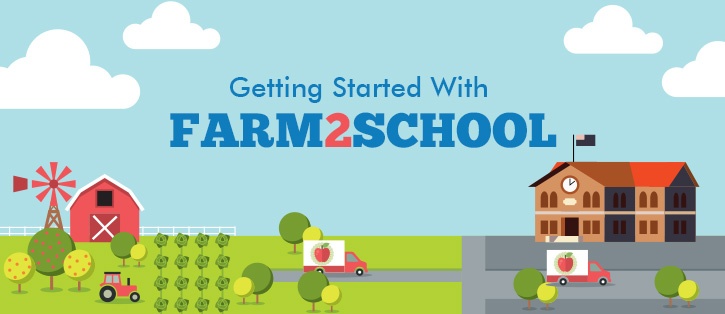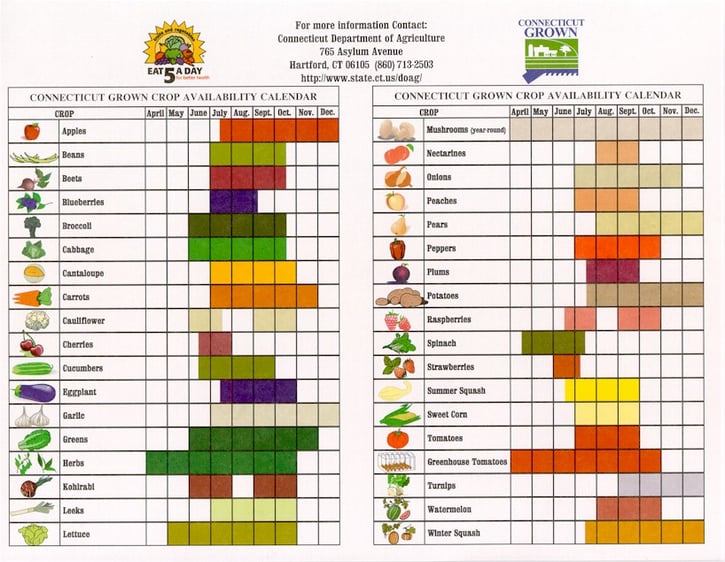
I'm sure no one will be shocked to hear that Farm to School has been growing in popularity over the last few years. So much so, that a recent national Farm to School Census conducted by the USDA, showed that roughly 42% of all districts surveyed participate in farm to school activities.
These programs include serving local foods in school meals, holding taste tests and food demonstrations showcasing local foods, and planning student field trips to farms or orchards. Another 16% of school districts surveyed plan to start farm to school activities in the future.
It's great to see such a positive trend taking hold in schools all across the country. Farm to School activities increase access to nutritious high-quality foods, support the local economy, and help get your community more involved in your program.
Is your district ready to get started with Farm to School? Here are some helpful tips to help you lay the groundwork for a successful program:
Build a team
Identify what key stakeholders will help you reach your goals. Are there specific people that you might need to seek approval from throughout this process? Who will this program impact and how might they contribute to its success? A short list of people for your consideration might include:
- School administrators (e.g. Principal, Vice Principal)
- School board members
- Food producers
- Teachers
- Parents
- Students
- State agency farm to school coordinator
Set short and long term goals
Think about what Farm to School goals you'd like to achieve in the near term and how you see the program evolving in five, ten, and even 20 years down the road. Ask yourself questions like:
- What types of Farm to School activities do you want to offer?
- How many local products would you like to feature on your school menus?
- Will you plan any taste test or food demo events?
- How might this program fit into your district's wellness policy or academic curriculum?
Most importantly, start small and stick with what's feasible for you and your district. Meeting your objectives early on can help get further buy-in from all your key stakeholders.
Find local products
Before you start looking for local products, you should first define what "local" means. It can be based on:
- Certain number of miles
- Within a county
- Within a state
This definition can vary from district to district depending on the level of accessibility of local products. Knowing exactly what "local" means in your district, makes it easier to understand market availability, create solicitations, and keep a tally of local products.
To get a good idea of what's available in your area, take a look at resources like local growing season charts, the USDA Census of Agriculture, producer associations, the Farm to School Census, Farm Service Agency (FSA) county offices, and cooperative extensions.
 Connecticut Grown Crop Availability Calendar
Connecticut Grown Crop Availability Calendar
Then, take a look at where you're currently sourcing your food products from. Are you already working with an existing wholesaler/distributor? If so, find out what local products are currently available. In many cases, this may be an easier than trying to work directly with local suppliers.
Additionally, you may want to consider other options for sourcing local products:
- Producers (farmers, ranchers, fisherman)
- Food Service Management Companies
- Auctions
- Co-ops & Food Hubs
- Food Processors
- School Gardens
Buying local products
Even though 'local' can't be used as a product specification in school food solicitations, there are many ways to purchase local products, while still adhering to federal, state, and local procurement rules.
If your purchase falls below the small purchase threshold (federal threshold limit = $150,000), you can use the informal procurement process to target 3 or more local farms or vendors to get quotes from.
Defining certain technical requirements and product specifications in your solicitation can help increase the likelihood that products are produced nearby, including:
- Freshness
- Harvest technique
- Production practices
- State of origin labeling
- Ability to provide farm visits or visit classrooms
If you're issuing a request for proposal (RFP), you can use evaluation criteria to weigh the importance of factors other than just the product itself (e.g. freshness vs price). RFPs using evaluation criteria must describe what those criteria are, how important they are, and how they will be used to assess each incoming proposal.
The geographic preference option can also be used as an evaluation criteria to specifically procure unprocessed locally grown or raised products.
Plan your menus
Before you make any menu changes, pay close attention to your budget or time constraints. Ask yourself, will local products cost more, less, or the same as their non-local equivalents? Will these foods take more or less time to prepare?
Forecasting is also critical to make sure you order just enough local products for each school site. Looking at production records and average daily participation in your Menu Planning and Point of Sale programs is a great place to start.
Then, review your current menus to see if any of the products listed are already purchased locally, such as milk. Based on locally available products, what non-local items could you consider substituting (e.g. purchasing local apples instead of non-local bananas)? If needed, develop new recipes to feature locally produced foods.
If you use cycle menus, consider modifying them for each season to take advantage of local products. Check with your state agencies to see if they offer cycle menus that feature local foods. They may have already completed some of the hard work for you!
Here's some other great ways to feature local products:
- Offer a daily salad bar to introduce more locally produced fruits and vegetables that require a minimal amount of preparation
- Start of a Harvest of the Month program to highlight a local ingredient
Once you've settled on some menu changes, think about how you'll gauge student acceptance. Consider holding a taste-testing session. It's a great way to get kids involved in the process of determining what makes it on the menu. You can also analyze sales reports or conduct a plate-waste study after the recipe is made available to gain further insight.
Review product safety and conduct training
When sourcing local foods from multiple vendors, it's always good to make the following safety considerations:
- Check local and state health requirements to see how it might impact your program
- Review kitchen food preparation and handling procedures to see if changes are needed
- Determine if additional food safety training is needed for staff, students, or volunteers that may help prepare or serve food
- If you have a school garden, evaluate what measures need to be taken to ensure food that's grown and harvested is safe to eat.
- When working with local producers find out what safety procedures they have in place. You might also want to considering adding some safety specs into your solicitations to make sure they are held accountable.
- Keep good records for traceability. In the event of a recall or safety concern, you should be able to track where specific ingredients came from and who they were served to.
- Confirm with your district if they require producers to carry liability insurance.
Market your program
Now that you've laid the groundwork for a great Farm to School program, now you need to get the word out. Think about your entire school community and how to plan to work with and share in the success of this program.
- Put up signs, posters, and tabletop displays in the cafeteria
- Update digital signage to include messaging about your program
- Post something on your district's website or associated social media pages
- Put an article or ad in your school newsletters
- Have a presence at school events or your Parent Teacher Association
- Enhance your school menus to mention local foods
Education & Curriculum
Educating students is an integral part of any successful Farm to School program. Work with teachers to integrate some food- and nutrition-centric lessons into the class curriculum. Some subjects such as science and health may be a good place to start.
 Fruit + Vegetable Fact Sheets / Nebraska Extesion in Lancaster County
Fruit + Vegetable Fact Sheets / Nebraska Extesion in Lancaster County
Consider field trips to local farms, food processing facilities, or your school garden so students can learn more about how food makes it to their lunch tray. Farmers or representatives from these places may also be able to speak to students, if field trips are not an option.
You could also get your staff involved in putting together culinary activities that teach students about food preparation and cooking healthy food.
Measure your success
The most important part of any farm-to-school program is measuring your progress. This allows you to find out what is and is not working. Here are some ideas for what to measure:
- Change in the amount of locally sourced foods
- Student meal participation
- Impact on program revenue
- Labor costs/operational costs
- School community attitudes towards this program
- Economic impact to local food producers
Use these results to share your successes and make adjustments to your program's goals and overall strategy.
Have you already implemented a Farm to School program? Help your fellow foodservice professionals and share your tips below!








